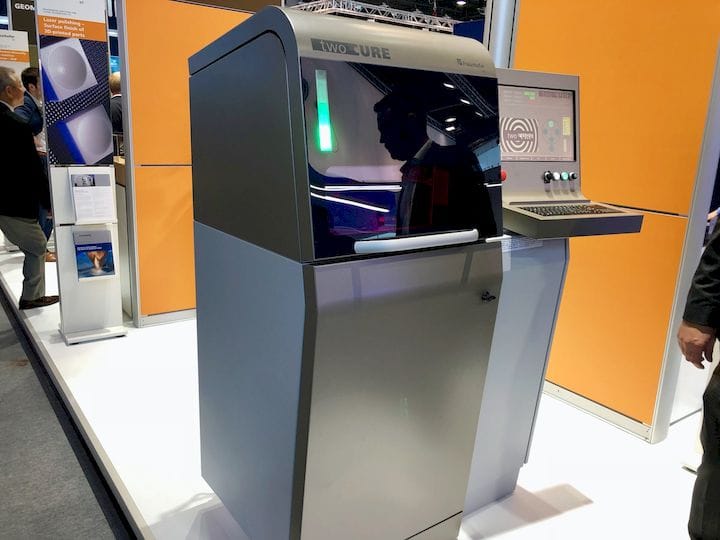![The incredible TwoCure 3D printing process [Source: Fabbaloo]](https://fabbaloo.com/wp-content/uploads/2020/05/image-asset_img_5eb0a2907badb.jpg)
I have seen the future of polymer 3D printing, and it is called TwoCure.
At formnext this week we ran across an entirely new 3D printing process that appears so incredibly compelling it was the highlight of the show. If the folks behind this process are successful in commercializing it, we could see a dramatic increase in polymer 3D printing in the future.
Developed by Holger Leonards and Andreas Hoffmann, with group leader Martin Wehner at the Fraunhofer Institute, the home of several notable 3D printing processes of the past, the TwoCure process is a resin-based approach that has the benefits of powder-based 3D printing.
You’re probably wondering how this mystery process works, and let me tell you now.
The key to the system is the unique resin, which has a melting point of only 15C. This means it is in a liquid state above that temperature, but a solid below that temperature. The resin is stored in a “warm” (room temperature) reservoir at the top of the machine before printing begins.
![The TwoCure upper reservoir and DLP unit [Source: Fabbaloo]](https://fabbaloo.com/wp-content/uploads/2020/05/twocure-reservoir-1_result_img_5eb0a290e487f.jpg)
To print, a thin liquid layer is laid down on the build platform, which is in a chamber below the reservoir. This liquid layer is then illuminated by a DLP to quickly fuse portions of the liquid photopolymer layer into solid form. That isn’t so unusual.
But what is unusual is the next step: the build chamber is cooled down to below 15C. That’s below the freezing point of the special photopolymer resin, so after several seconds it will freeze solid. But this happens after the DLP has fused the selected areas of the layer. In their prototype machine, the DLP allows 50 micron resolution from its 2560 x 1650 pixel screen.
![The TwoCure resin system in operation [Source: Fabbaloo]](https://fabbaloo.com/wp-content/uploads/2020/05/image-asset_img_5eb0a2914353b.jpg)
A second layer of liquid is then deposited on the previous frozen layer, and the DLP / Freezing steps occur once again. Layers are continuously deposited in this manner until the entire model is built. At that point we have a complete 3D print, but it is encased in a frozen block of resin.
The machine, currently only a single prototype, then shunts the frozen block down a chute where it lands in a basket. The basket is then heated to melt the frozen portions of the resin, releasing the actual prints. The melted resin is collected through drain holes and is pumped back up to the reservoir for subsequent prints. No resin is lost.
![The melting station and object basket in the TwoCure system [Source: Fabbaloo]](https://fabbaloo.com/wp-content/uploads/2020/05/image-asset_img_5eb0a2918eb03.jpg)
At that point you have a basket with a set of complete prints. These prints are of the usual DLP high quality – and required NO SUPPORT STRUCTURES and thus have no support marks on their surface. In fact, no post-processing is required other than washing and additional UV curing, as is done in other SLA-like processes.
The implication of this process is profound: with TwoCure you can stack many parts into a print job in three dimensions, just like you would with a production powder machine, where the powder serves as support material. In TwoCure’s case, the frozen resin serves that purpose.
![Controller on the TwoCure system [Source: Fabbaloo]](https://fabbaloo.com/wp-content/uploads/2020/05/image-asset_img_5eb0a291d8169.jpg)
I now have a vision in which large TwoCure machines are busy building huge batches of 3D prints in overnight runs, just like large powder machines. It seems to me that TwoCure could eventually become a powerful production technology.
The resin is easily reused, and unlike powder processes there is no “splatter” from a powerful laser that requires sieving or introduction of new resin to improve the “fresh ratio”.
TwoCure will allow highly complex 3D models to be easily produced in resin materials, as you no longer have to be concerned about support structure removal.
The inventors described the resin as kind of mix between a thermoset and thermoplastic material, but for obvious reasons did not elaborate on its chemistry when we spoke with them. However, as everyone knows, resin is a very powerful medium, and there are countless variations that could in the future be used for, say, flexible, high-temperature, casting, composite or other functional purposes. The prototype machine we observed was using only a single resin, but clearly many more could be developed in the future.
As of this moment, TwoCure is merely a patented process developed by Fraunhofer inventors. There is no legal company formed to capitalize on it, and the inventors don’t even have a company name in mind. However, we had the distinct impression they were about to found a startup company, apply for funding and start commercialization.
TwoCure: watch for it.











A research thesis details the incredibly complex world of volumetric 3D printing. We review the highlights.